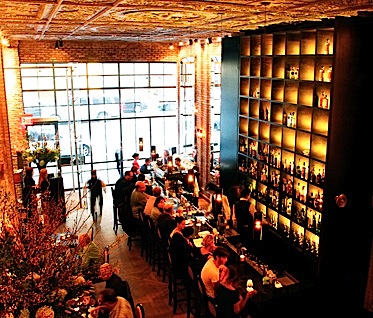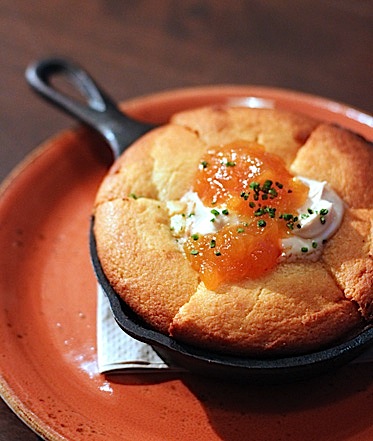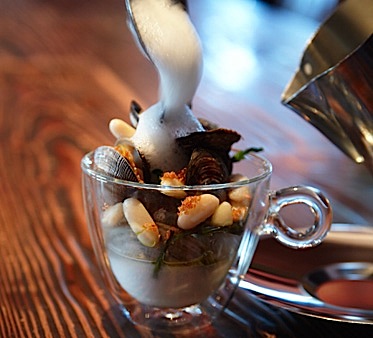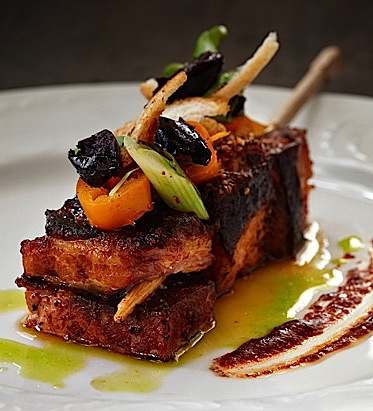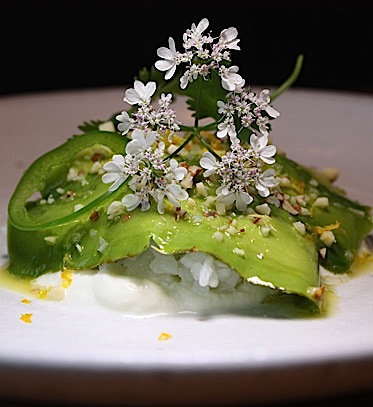MARIANI’SVirtual
Gourmet
October 13, 2013
NEWSLETTER
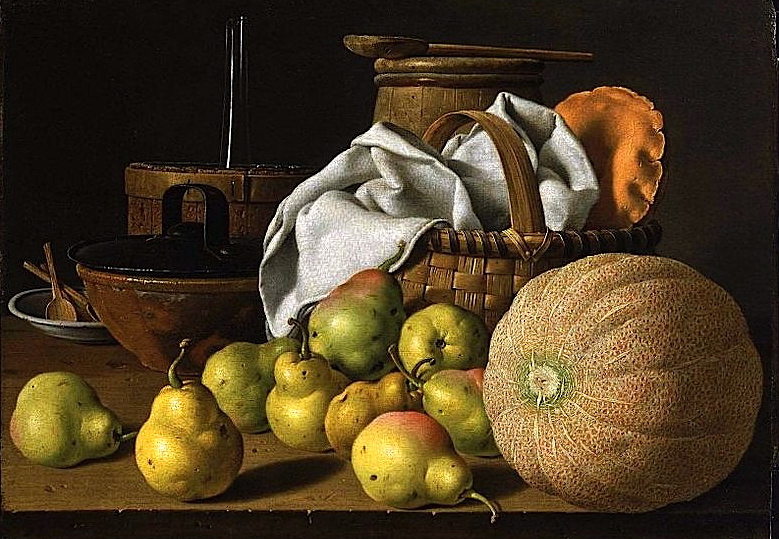
Luis
Melendez, "Still Life with Melon" (circa 1772)
THIS WEEK
JADE MOUNTAIN, ST. LUCIA
by Marcy MacDonald
BEST NEW RESTAURANTS OF
2013
by John Mariani
IL GATTOPARDO
by John Mariani
NOTES FROM THE WINE CELLAR
THE WINES OF RIVESALTES
by Brian A. Freedman
JADE
MOUNTAIN, ST LUCIA
by Marcy MacDonald
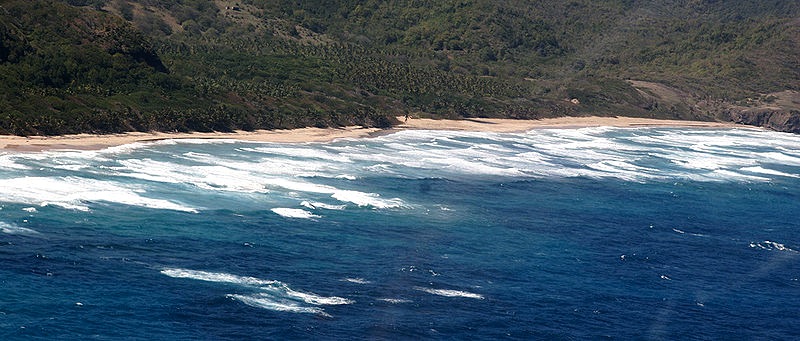
Atlantic Beach, St Lucia
Although Columbus may have discovered St. Lucia on his conquest of the Americas in the late 15th century, it was the French who named her and the English who fought for her.
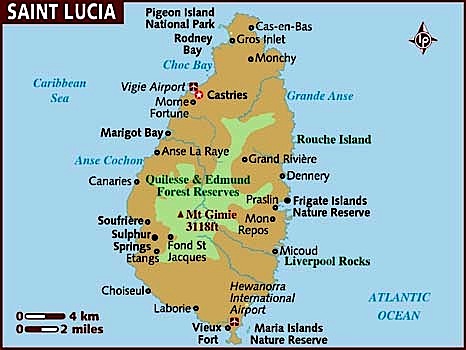 By 1814 the island had
switched political sides so often (seven wins and
losses, each) that she was known as the "Helen of
the West Indies" -- curiously located in the Eastern
Caribbean. Pirates loved Castries, an easy
port for docking, as most of the big cruise ships
still do.
By 1814 the island had
switched political sides so often (seven wins and
losses, each) that she was known as the "Helen of
the West Indies" -- curiously located in the Eastern
Caribbean. Pirates loved Castries, an easy
port for docking, as most of the big cruise ships
still do.
Early adventurers, however, sailed past the capital city and went to the west side of the island to find sulfur springs (where the future Empress Josephine bathed when she was still a girl from Trois Islettes in nearby Martinique), located near the seagoing city of Soufriére, and the remains of a volcano that is now a "drive-through" attraction, still the only one of its kind, anywhere. And, yes, it's "active."
Unlike most of the other Caribbean islands, St. Lucia is fabulously mountainous. The highest point may be Mount Gimie, at 3,120 feet above sea level, but two other mountains, the Pitons -- Gros and Petit -- form the island's most famous landmark and a recurring dream for many aesthetic explorers, including architect Nick Troubetzkoy and his wife, Karolina.
After St. Lucia's independence in 1979, the Troubetzkoys began to visit the island -- and tried to take the view home with them. "Nick had been collecting antique jade mountain objets d'art for 35 years before he saw the Pitons," the Mrs. affirmed. "But what was meant to be a brief stint in paradise turned into a lifelong passion for the island and its people." Troubetzkoy felt that the best view of the Pitons could be had from a few of the rooms at the nearby Anse Chastanet resort, and began negotiations to buy it. That accomplished, he designed and crowned the hill above it with his expression of his "organic" design.
"Nick was finally
carving his own Jade Mountain, perhaps a little
bigger than those in his collection," Karolina says
of the resort. He used local workmen to create an
über-luxe resort where open-air "sanctuary"
guest rooms feature 15-foot ceilings, an
ever-changing picture of his favorite view of the
Pitons and in many a 300-square-foot horizon
pool nearest the transparent wall, in contrast
to the deep Jacuzzis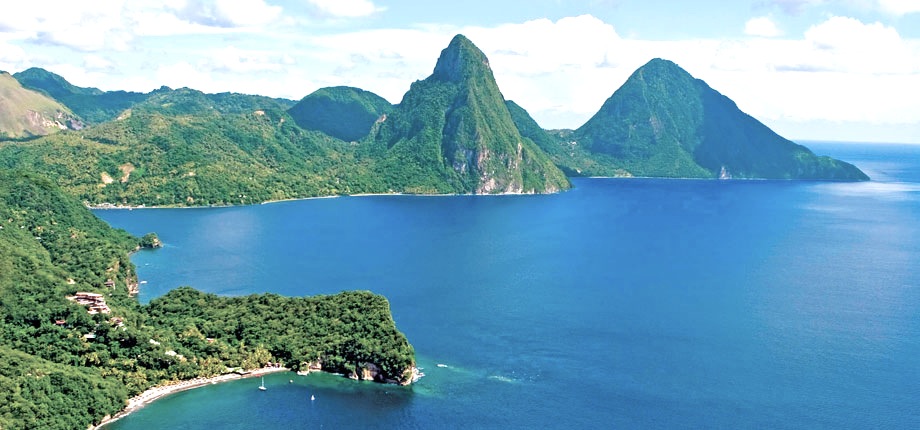 in the restful
restrooms. He used recycled glass pool tiles
(designed in collaboration with David Knox of
Lightstreams) to reflect the resident Koi fish and
glass lighting squares (that would be high and
mighty lighting structures if local birds hadn't
designated them their preferred habitat) that create
an atmosphere of an idealized
hyper-home-away-from-home, starring the Pitons.
in the restful
restrooms. He used recycled glass pool tiles
(designed in collaboration with David Knox of
Lightstreams) to reflect the resident Koi fish and
glass lighting squares (that would be high and
mighty lighting structures if local birds hadn't
designated them their preferred habitat) that create
an atmosphere of an idealized
hyper-home-away-from-home, starring the Pitons.
Designers lined up to supplement the locally made furnishings: Environment Furniture, Janus et Cie, Padmas Plantation as well as Hans Grohe and Duravit (for bathroom fixtures and fittings) because Troubetzkoy wanted each guest sanctuary to be a little different than the sanctuary next door. More than 20 species of tropical hardwood are subtly displayed in every room, all environmentally harvested, and include snakewood, etikburabali, futubali, purpleheart, locust and others with even stranger names. He designed hardwood stairs and ramps (to accommodate a very few motor vehicles) to connect the various levels of Jade Mountain, each artistically obscured by massive bursts of green; a secret spa; a little bar or two or three; a shop around an unexpected corner; another glass of island cheer; an outcropping of flowers; a selection of mad hats; an art gallery; a fitness studio; more and better details, details, details and giant, economy-size bottles of sunblock.
 As
the Troubetzkoys realized their artistic 24-room
dream, they began to shop for a chef. Their favorite
was Allen Susser, proprietor of Chef Allen's in
Miami and an early winner of the James Beard Award
for outstanding chef. Susser took one
look at the architectural designs (and a wander
through Farmer John's house and tree-growing grounds
-- yes, really -- a third-generation plantation
farmer, down mountain from and now part of the
resort), and began to plan his ideal "Jade cuisine"
menus.
As
the Troubetzkoys realized their artistic 24-room
dream, they began to shop for a chef. Their favorite
was Allen Susser, proprietor of Chef Allen's in
Miami and an early winner of the James Beard Award
for outstanding chef. Susser took one
look at the architectural designs (and a wander
through Farmer John's house and tree-growing grounds
-- yes, really -- a third-generation plantation
farmer, down mountain from and now part of the
resort), and began to plan his ideal "Jade cuisine"
menus.
"The Jade Mountain plantation provides the resort with most of the fruits, vegetables and the cacao we use in a variety of dishes there," the chef says. Guests are invited to tour the farm, along with the farmer, chef and sous chef, to see the raw materials used to concoct the new and exotic as well as the tried-and-true. Often, entire dishes, sauces, spices and rubs are devised during the course of these outings down on the farm. Chefs are forever experimenting at reinventing the wheel -- in full view of the guests.
"There was a time when we just sent all of our cacao pods up to Hershey, Pennsylvania, for refining. But there were so many cacao trees on the plantation that we began to produce our own chocolate a couple of years ago," the chef explained. "What's amazing is the process, the time it takes to harvest the cacao bean from the pod to produce a tiny sliver, the nib -- about the size of a fingernail tip -- essential to chocolate-making."
Amazing that the first purveyors of chocolate, the Maya, ever took the time to turn the cacao pod into a potion fit for their kings a few hundred years before they had even invented a language.
Although St. Lucia
officially speaks English, an Antillean French
Creole is used in literature, music and menus,
and is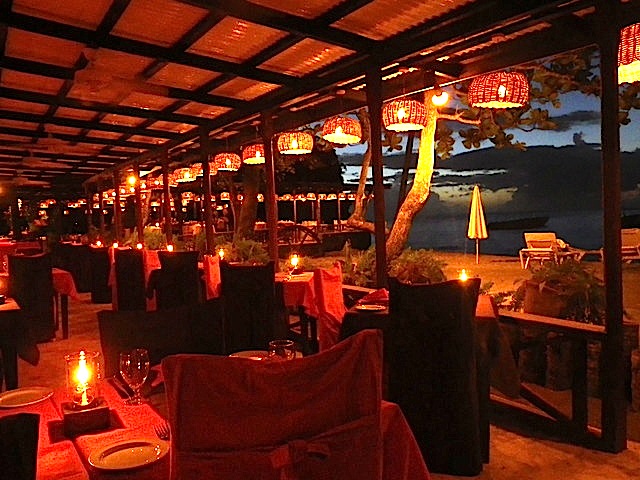 gaining
official acknowledgement, particularly by the
Chastanet family, whose newest generation has
provided the young nation with its current Prime
Minister, who has been known to make himself at home
for the East
Indian cuisine in the Apsara Beachfront 14-seat
dining room at Anse Chastanet (dinner runs about
$100 for two), he makes himself at home in Jade
Mountain’s 14-table restaurant by reservation only
for about $170 for two -- worth every penny of
your EC currency. Chef Allen's famous Spices
of the Caribbean Culinary menus keep the
gourmands coming up the mountain for more. And
more -- as these special gastronomic adventures
are packaged as "all-inclusive" weekend and
week-long events. Generally, the only items not
included in the price are the special daily
cocktails, champagne (but at $130 per, the bottles
of Moët are considered a bargain), cognacs,
rums and malt whiskeys, not to mention spa dates,
unscheduled adventures off property and gifts and,
needless to say, the $350 charge for an underwater
wedding.
gaining
official acknowledgement, particularly by the
Chastanet family, whose newest generation has
provided the young nation with its current Prime
Minister, who has been known to make himself at home
for the East
Indian cuisine in the Apsara Beachfront 14-seat
dining room at Anse Chastanet (dinner runs about
$100 for two), he makes himself at home in Jade
Mountain’s 14-table restaurant by reservation only
for about $170 for two -- worth every penny of
your EC currency. Chef Allen's famous Spices
of the Caribbean Culinary menus keep the
gourmands coming up the mountain for more. And
more -- as these special gastronomic adventures
are packaged as "all-inclusive" weekend and
week-long events. Generally, the only items not
included in the price are the special daily
cocktails, champagne (but at $130 per, the bottles
of Moët are considered a bargain), cognacs,
rums and malt whiskeys, not to mention spa dates,
unscheduled adventures off property and gifts and,
needless to say, the $350 charge for an underwater
wedding.
Guests who book these special foodie events are welcome to dine almost anywhere on the property (including their private sanctuaries). Each Major Domo provides superb and subtle service: Teddy-the-Perfect-Butler will worry himself sick if he doesn't see you enjoying your meal, wherever in the resort you experience it.
Breakfast is often as experimental in the dining room at Jade Mountain as it is traditional in the restaurants down mountain at Anse Chastanet. And yes, guests who are already fans of Theresa Henry's bakery shack in nearby Soufriére still wait for breakfast until they can smell the fragrant bread being delivered to the resort each morning. After 60 years, 14 children and making thousands of Creole baguettes, the baker retired in 2006 to watch her daughters run the place. Ask for Jade Mountain's pulled-pork sandwich on her baguettes for one of the best taste treats on the island.
Nor is Chef Allen (below) a stranger to Chocolate Weekends (even entire chocolate months) on the island, where some of the best and tastiest end-results in the Caribbean are produced. Chocoholics may agree that in St. Lucia there is nothing quite like drinking a chocolate milkshake, enhanced with local Crystal white rum, while gazing at the Pitons through the bottom of a very large glass -- steps from the Yoga class they may miss entirely.
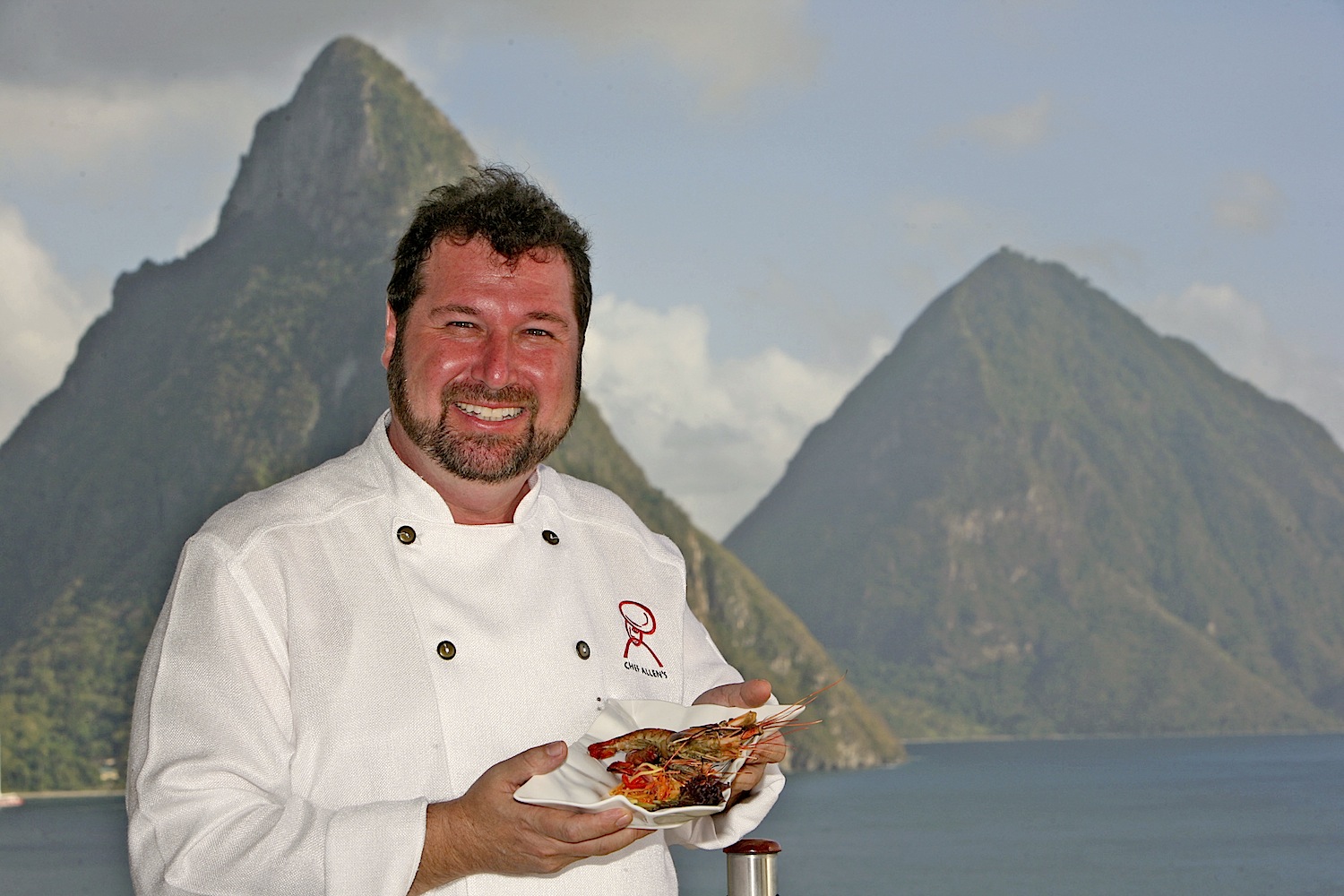 Do
be certain you're expected (a reservation for
dinner, a tour around the plantation or a beautiful
week of grazing and viewing the Pitons is required),
as they've already chilled one of the chef's
favorite rum drinks for you at check-in, a kind of
green Cabin in the Sky (equipped with a couple of
computers for twitchy guest use). From then
on, your butler is in charge of your life: you
needn't worry about drowning in the spacious Jacuzzi
or the horizon pool because, if they don't hear from
you on the tiny pocket phone often enough, they send
out a search party. Yes, really. Even if
they take you on the launch into town, they want to
hear from you from time to time.
Do
be certain you're expected (a reservation for
dinner, a tour around the plantation or a beautiful
week of grazing and viewing the Pitons is required),
as they've already chilled one of the chef's
favorite rum drinks for you at check-in, a kind of
green Cabin in the Sky (equipped with a couple of
computers for twitchy guest use). From then
on, your butler is in charge of your life: you
needn't worry about drowning in the spacious Jacuzzi
or the horizon pool because, if they don't hear from
you on the tiny pocket phone often enough, they send
out a search party. Yes, really. Even if
they take you on the launch into town, they want to
hear from you from time to time.
Other than that, you'll never see them when they replace the contents of the fridge and they'll replace whenever you're not looking. Brunch and afternoon snacks are a must.
Time to mentally undress, wrap a pareo (aka sarong) around you and grab a hat. You may be in time for early morning or late afternoon yoga, massage, shopping, loafing until Chef Allen's last supper.
All of the entries are
based on "ingredients locally farmed, harvested and
fished," and include everything from daily fruit
juices to freshly laid eggs. But each day of the
Spices of the Caribbean Week may feature another
tour of Farmer John's acreage for Chef Allen's top
ten spices: cumin, black pepper (they even use it in
a variety of massages to relax tired muscles in the
treatment of arthritis, chilblains, constipation,
cramps, digestion and circulation), cinnamon,
cloves, cardamom, allspice, nutmeg, coriander, star
anise and turmeric (it's also used in tea 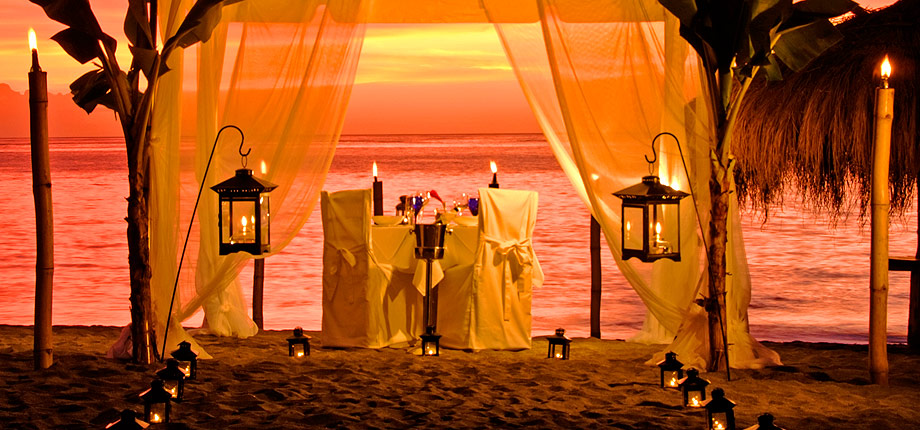 as a rheumatism remedy).
as a rheumatism remedy).
The chef begins with the wine pairings that chief steward Eric Toles will pour every evening. On Fridays guests are toasted by Chef Allen's hand-shaken Jade spiced rum cocktail, which combines sustainable local exotics from the Emerald Gardens, downhill, to the local rum; a good start to the gourmet days ahead. If guests select from Chef Allen's Spice Menu (a seven-course nightly offering), the bill will be about $85 per person per meal (plus a 10% service charge and 8% government tax) on their all-inclusive plan, plus liquids and solids not included, like Brandy or any drink with a flame fanning out of it. Of course, if the Kobe beef is too wonderful to ignore;, indulge instead.
For instance, the Emerald Vegetable Wrap in Rice Paper features all locally spiced pumpkins and green bell peppers in a cumin raita, which Eric pairs with a nice dry, smoky non-vintage Moet. You can taste every ingredient. Try one of these for the second course: The coriander grown on the property morphs into coriander seared foie gras with compressed pineapple and raspberry sea salt from the Caribbean. The combination of the salt and the sweet was made even more interesting by the addition of a glass of Arthur Metz Gerazinger Certzaler -- dry in the mouth, but sweetish in the finish. The passion fruit and sesame glazed shrimp looks like the more recognizable of the two early courses, but add melon mojito salsa with a Campari foam).
 The
third course may feature two entrees, both of which
you covet. A beautiful, freezing, dry rosé
from the Côtes de Provence is soft on the
palate and slightly fruity with both the
almond-crusted goat's cheese served with local
greens, tomatoes, lightly grilled onions and
sun-dried tomatoes, or the organic mustard
greens, grilled and lightly dressed with a cucumber
mustard seed vinaigrette).
The
third course may feature two entrees, both of which
you covet. A beautiful, freezing, dry rosé
from the Côtes de Provence is soft on the
palate and slightly fruity with both the
almond-crusted goat's cheese served with local
greens, tomatoes, lightly grilled onions and
sun-dried tomatoes, or the organic mustard
greens, grilled and lightly dressed with a cucumber
mustard seed vinaigrette).
For the intermezzo: a passion fruit and raspberry sorbet, then the main course, line-caught Kingfisher steak paired (unsuccessfully, I thought) with a Hob Nob Pinot 2010, happily because of the lentil and green banana Lyonnaise, over which a nice, crunchy celery salsa complements the purple long beans. A dry Pinot Grigio or Sauvignon Blanc goes perfectly with the garam masala grilled pork tenderloins with spiced sweet potato, ginger, bok choy and barbequed papaya from the farm for a more delicious 'white' meat than you've ever eaten.
If you have an inch left for dessert, there are several to share: cardamom spiced crème brûlée, spiced chocolate truffles and-- in case you've gone 'calorie light' -- the black rice spring roll, unlike any other spring roll, ever: even the rice is light, slightly crunchy.
HOW TO GET
THERE: Jet Blue flies daily from the New York
airports; American Airlines flies
from Miami; Delta wings in from Atlanta;
Air Canada and West Jet carry passengers from
Toronto, as well as British Airways and
Virgin Atlantic from London. Although rental
cars are plenty, almost all of the resorts have
'meet and greet' people at the airport to
organize transport.
❖❖❖
THE BEST
NEW RESTAURANTS OF 2013

To the rest of the world, American
restaurants have become as copied as blue jeans and
hip hop, so that steakhouses and hamburger stands, lobster
rolls and Cobb salads have become the hot items from
Dublin to Dubai.
Which doesn’t surprise me: our
restaurants, from A to Z, are more innovative than
ever before, not least when shining Asian, Spanish,
Peruvian or Nordic food through an American prism
while constantly refining our own regional foods,
from shrimp and grits to banana cream pie with proud
panache.
So here are my picks in this month's Esquire
Magazine for the best new restaurants to have
opened in the past twelve months in America, listed
alphabetically.

THE HALL OF FAME
The Maccioni Family of Le Cirque, NYC
(left to right, Mario, Mauro, Sirio,
Egi, Marco)
Betony, NYC
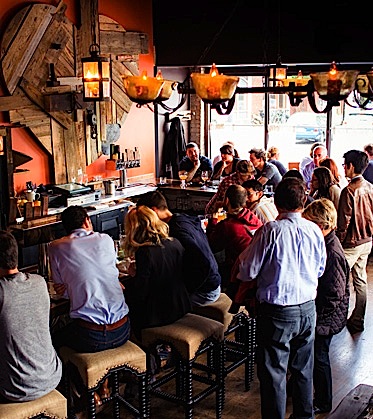
Bronwyn,
Somerville,
MA
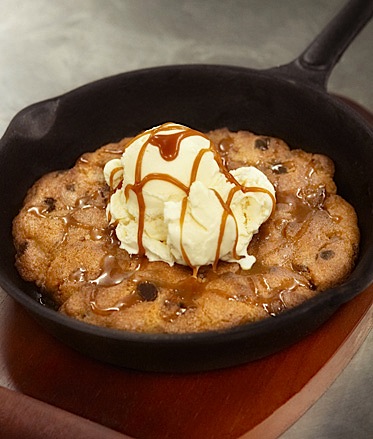
Blue
Dragon, Boston, MA
Carriage
House, Chicago,
IL
Coqueta, San
Fransisco, CA
Michael
Chiarello is Esquire’s
Chef of the Year.
Del Campo, Washington,
DC

The
Elm, Brooklyn, NY
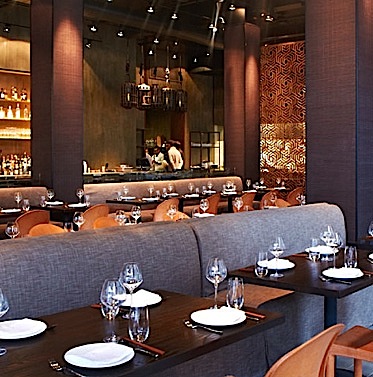
Embeya, Chicago, IL
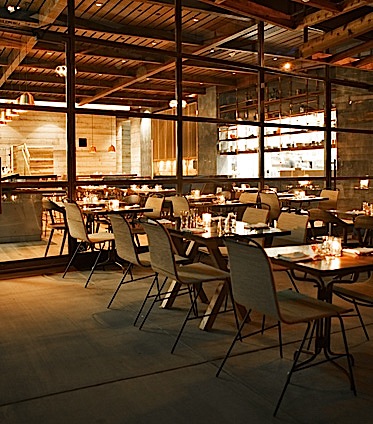
Hinoki & The
Bird, Los Angeles, CA
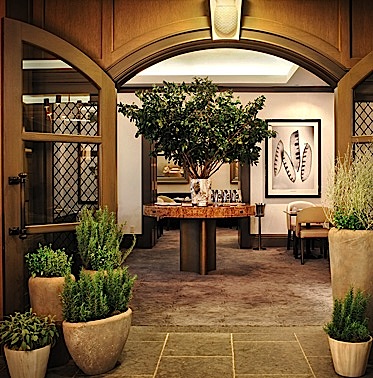
Juni, NYC.
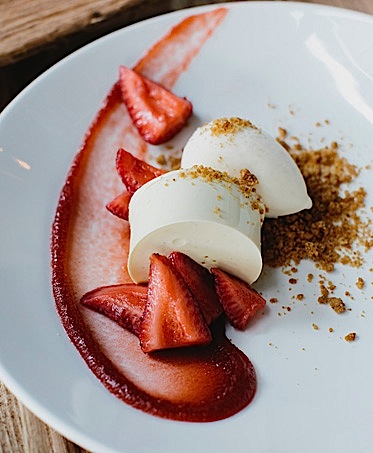
King + Duke,
Atlanta, GA

Mariza,
New
Orleans, LA
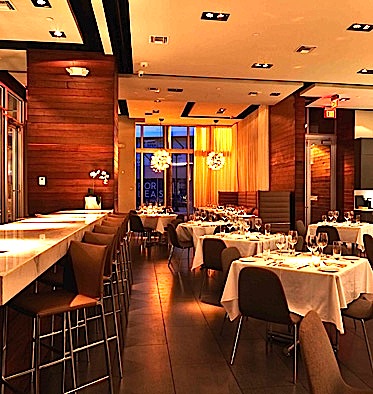
MC
Kitchen, Miami, FL
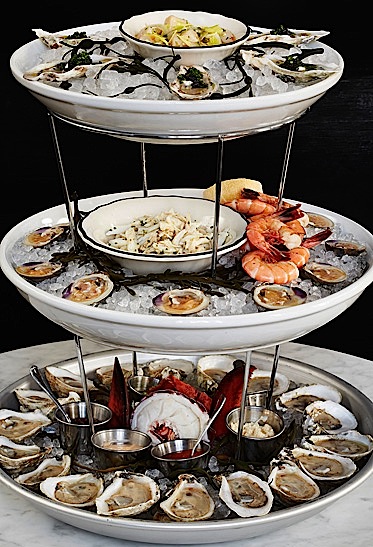
The Ordinary,
Charleston, SC
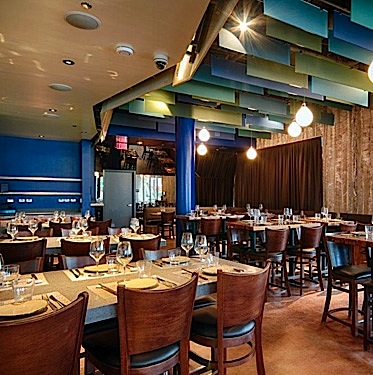
Paiche, Marina del
Rey, CA
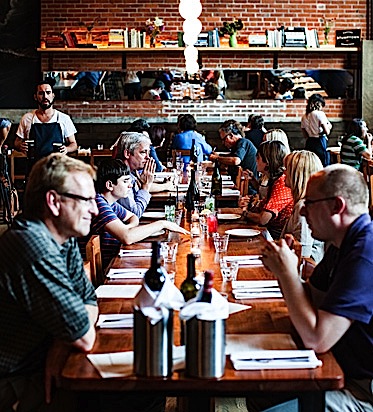
Rolf and Daughters,
Nashville, TN
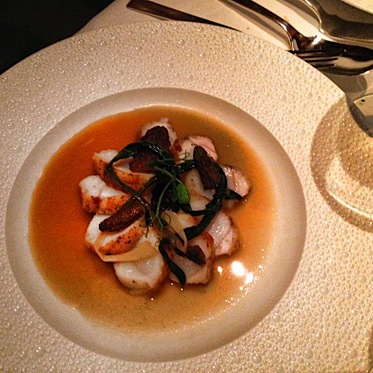
Spoon Bar &
Kitchen, Dallas, TX
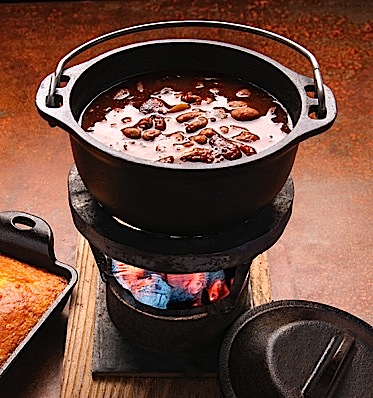
Stampede 66,
Dallas, TX
Stella
34, NYC-
Trois Mec, Los
Angeles, CA
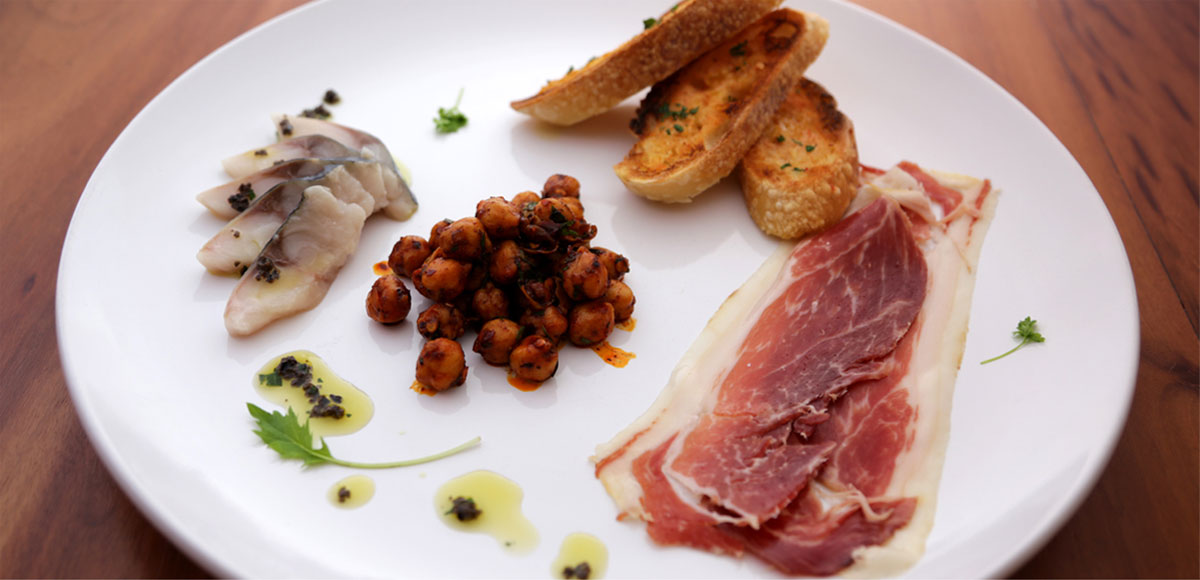
Virtú
Honest Craft, Scottsdale, AZ
◆◆◆
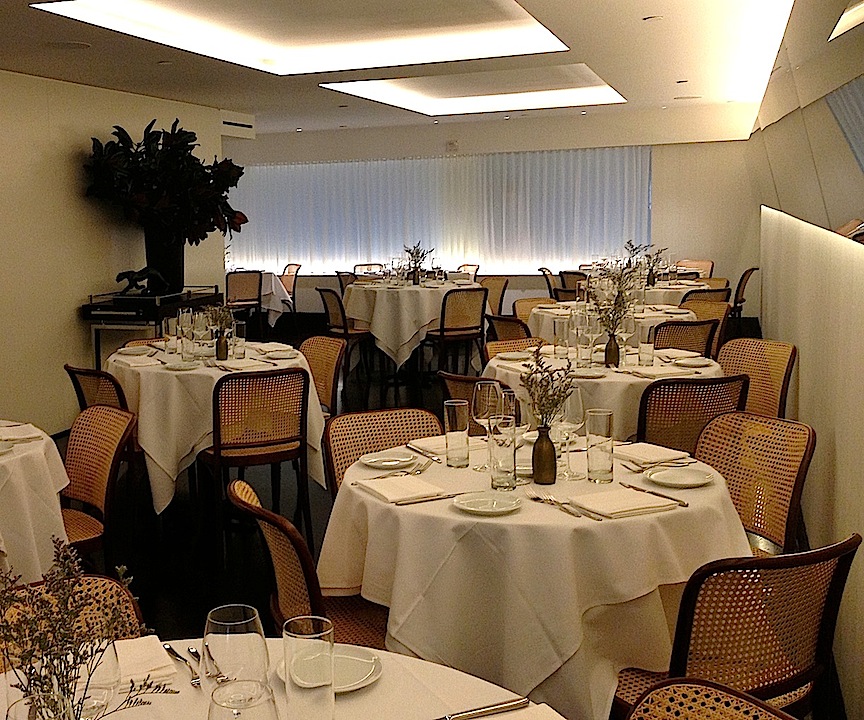
by John Mariani
Il Gattopardo
13-15
West 54th Street (near Fifth
Avenue)
212-246-0412
Nothing makes me wag my head more than those food hipsters who contend that restaurants with 15 seats, no décor, no reservations, ear-shattering noise and expensive food are the most popular of the moment. In one sense, they’re right—for the moment, they may well be. And the media fall right in line, hyping restaurants with three-hour waiting lines down the block. Of course, the media, with private phone numbers to call, do not wait on such lines.
But
they
are dead wrong if continued, unstinting popularity
and regularity of visits by a faithful clientele are
the criteria. Add to those elements
well-appointed tables, refined décor,
reservations graciously accepted and a reasonable
noise level, and you have an enormous range of
restaurants in NYC whose proprietors couldn’t care
less about what is trending in Flatbush or cresting
in Losaida. Among such restaurants is Il
Gattopardo, sister to 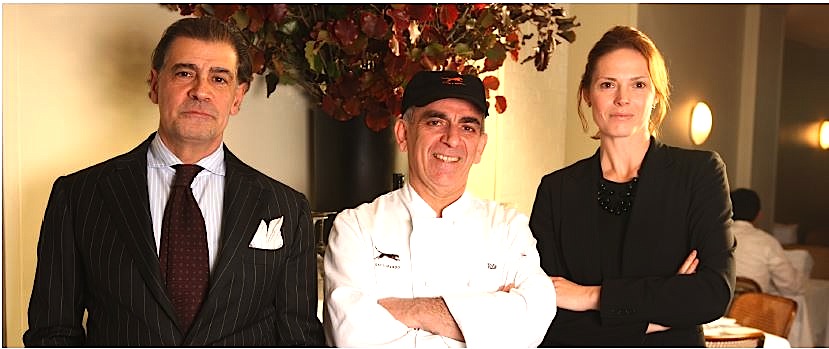 The Leopard
across from Lincoln Center, where owners Gianfranco
and Paula Sorrentino (left, with Chef Gnazzo) have for
more than a decade been serving superb Italian
cuisine to a clientele they know by name and who may
very well dine here two or three times a week.
The Leopard
across from Lincoln Center, where owners Gianfranco
and Paula Sorrentino (left, with Chef Gnazzo) have for
more than a decade been serving superb Italian
cuisine to a clientele they know by name and who may
very well dine here two or three times a week.
Named after the great 1958 novel of Sicilian life, Il Gattopardo by Giuseppe di Lampedusa, the restaurant recently shifted eastward a few doors away from its original location on West 54th Street, taking over the former Beaux Art Rockefeller townhouse that had once been home to the Scandinavian restaurant Aquavit.
Gianfranco is a proud Neapolitan, and he and chef Vito Gnazzo feature the food of Southern Italy. Gnazzo had worked at the renowned Antica Osteria del Ponte in Milan, then at the equally esteemed Rex in Los Angeles before becoming Executive Chef at Sette MOMA the Museum of Modern Art across the street.
The renovation of the new premises, overseen by Paula, has been extensive, with the grand downstairs room (below) now reserved for parties. There is a fine-looking bar upstairs (which is actually down one flight from the street) and the long dining room looks more spacious than it used to, done all in off-white tones with wicker chairs. The ceiling lighting is soft but could be turned up a few watts, and a bit more color wouldn’t hurt the spirit of the room.
Gnazzo’s
menu
contains much that is unique to Il Gattopardo, along
with classic Italian dishes done here as well as
anywhere in NYC.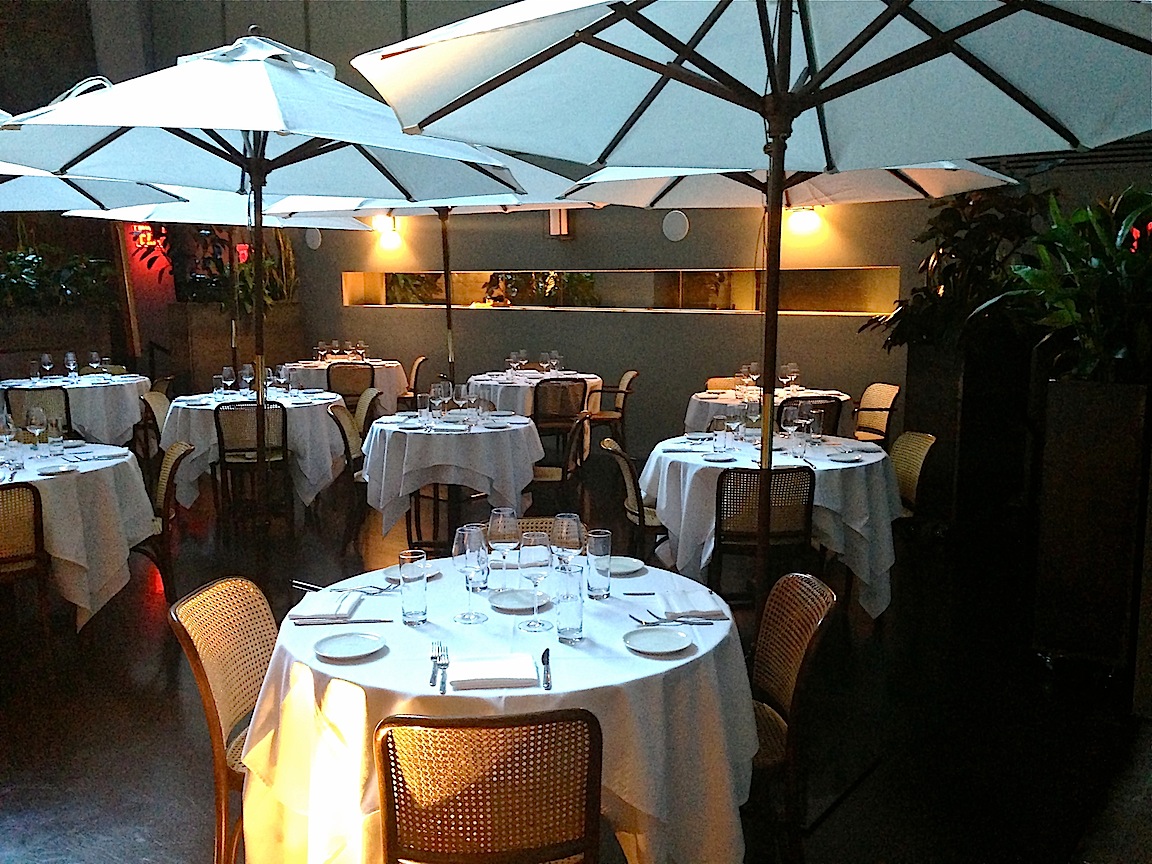 The wine
list is first class, with an admirable selection by
the glass, including Martinetti Bris del Banditi
Barbera d’Asti 2010 and Gaglioppo “Odoardi”
2004.
The wine
list is first class, with an admirable selection by
the glass, including Martinetti Bris del Banditi
Barbera d’Asti 2010 and Gaglioppo “Odoardi”
2004.
There are ample novelties among the antipasti, like delicious eggplant and buffalo ricotta cakes with a spicy tomato sauce; parmigiana of zucchini with smoked scamorza mozzarella, tomato and herbs; and meatballs wrapped in cabbage leaves with a thyme sauce.
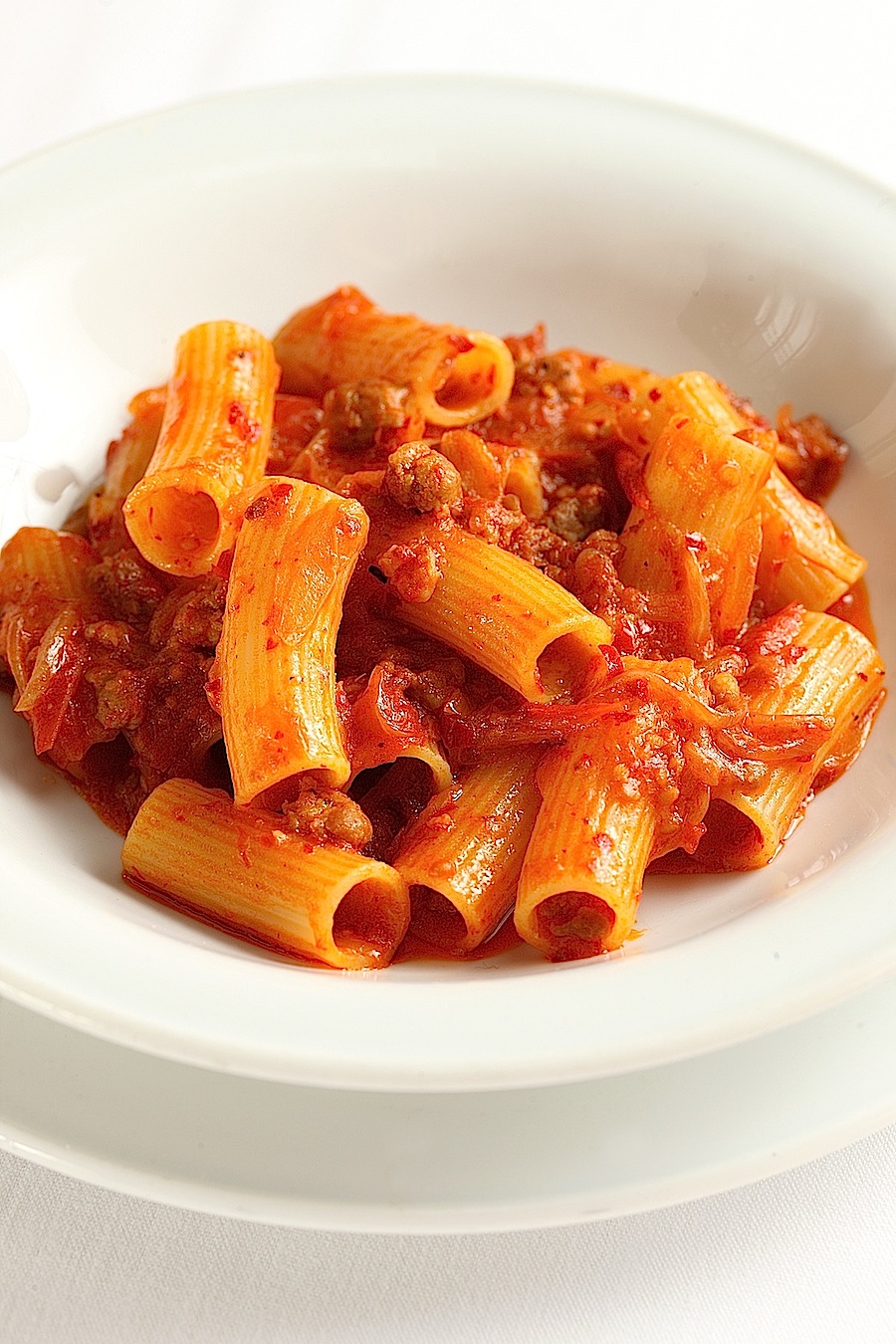 Every
pasta
I tried--all blissfully al dente--was superlative, from
rigatoni with a hot and spicy ‘nduja
sausage sauce with onions and rosemary (left), to scialatiello
pasta swimming in a fabulous shellfish ragout.
Most interesting of all—with a good story
behind it—is the lusty paccheri tubes
with a “Genovese” sauce, which you might expect to
be a pesto; instead it is a sauce of onions,
carrots, celery and pork ribs cooked for hours in
white wine till soft and sweet, then added to the
macaroni. The name comes from the practice of
visiting Genovese sailors in Naples who kept cooking
while drinking wine; the Neapolitans picked up the
idea and so called in “Genovese.”
Every
pasta
I tried--all blissfully al dente--was superlative, from
rigatoni with a hot and spicy ‘nduja
sausage sauce with onions and rosemary (left), to scialatiello
pasta swimming in a fabulous shellfish ragout.
Most interesting of all—with a good story
behind it—is the lusty paccheri tubes
with a “Genovese” sauce, which you might expect to
be a pesto; instead it is a sauce of onions,
carrots, celery and pork ribs cooked for hours in
white wine till soft and sweet, then added to the
macaroni. The name comes from the practice of
visiting Genovese sailors in Naples who kept cooking
while drinking wine; the Neapolitans picked up the
idea and so called in “Genovese.”
The
same
Neapolitan meatloaf that has become a favorite at
The Leopard has become just as popular at ll
Gattopardo, thick, juicy, well textured not to fall
apart, with chive-dotted mashed potato and
garlic-riddled spinach. Well-fatted Colorado rack of
lamb is crusted with herbs and served with a potato
croquette, sautéed spinach and an
assertive mustard sauce. But my favorite
dish—since it is so rare in these parts—was a true baccalà
(below)
cooked in a casserole with black olives, capers,
cherry tomatoes and potatoes. This is the kind of
hearty dish the hero of the novel, Don Fabrizio,
preferred eating to the French-ified dishes so
often served at aristocratic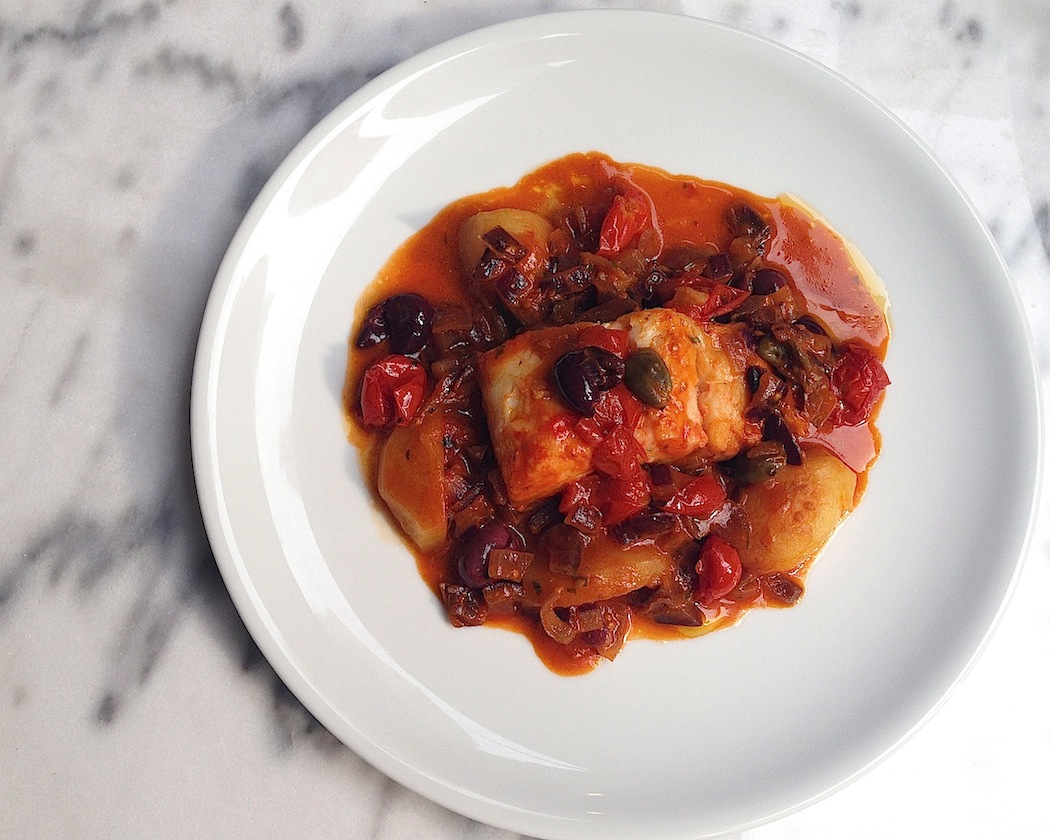 tables.
tables.
Don’t leave the table without trying at least one dessert, perhaps the pistachio tart with vanilla gelato, which is fairly light, or the traditional Neapolitan cheesecake or the rum baba with limoncello-dunked strawberries.
Il Gattopardo gets a well-heeled, well-dressed clientele, which includes all the museum and gallery people who are not dining across the street at The Modern, and celebrities like Paul McCartney (who eats vegetarian here) and Stanley Tucci rub elbows with fashion designers like Miuccia Prada.
Yet
the
Sorrentinos and their staff are as gracious to a
newcomer as they are to a faithful regular.
Which means that Il Gattopardo is packed every
day and evening--not just for the next few weeks
until the new-ness wears off, but for years, even
decades to come. It’s a dining room for grown-ups
and it is as fine a Southern Italian restaurant in
NYC as you’ll ever find.
Lunch, Mon – Fri.;
brunch Sat & Sun; dinner nightly. Antipasti
$9-$22, pastas $20-$23, main courses $24-$46.
❖❖❖
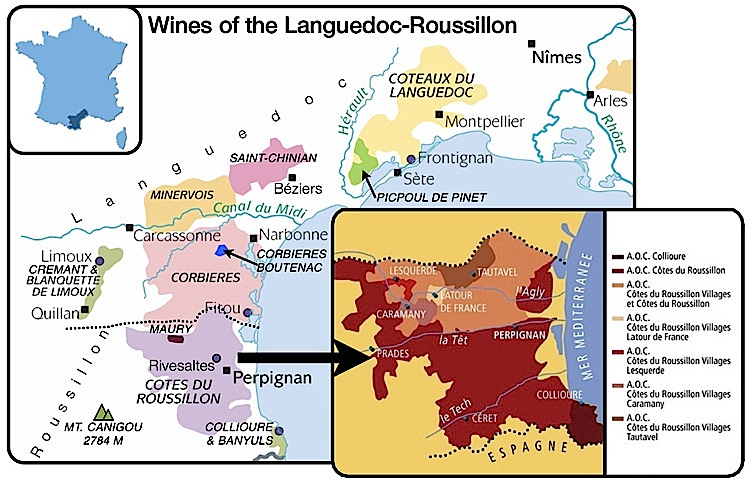
THE ROUSSILLON WINES OF RIVESALTES
by Brian A. Freedman
"Old wine is good wine." Really?
This is one of the major fallacies of the beverage world, and among the uninitiated it remains cause for deep misunderstanding. At least once a month, I’m asked by a consumer or client if their bottle of ancient such-and-such is still drinkable. And more often than not, the answer is a hearty “no.”
Wine, like all of us, has a lifespan, and each individual bottle will go through some version of the classic evolution: From youth to awkward adolescence to maturity to the inevitable downslope. The truth is that most wines’ lifespans run out over a relatively short stretch of years. The majority of bottles are meant to be consumed as soon as you bring them home from the store, and certainly within a year or three.
My advice, then, is simple: Buy it, drink it, and move on.
But there’s another category of wine, of juice that somehow possesses the ability not just to age, but to do so with a grace and longevity that would make retired supermodels jealous. These bottles just keep on getting better and more interesting with time; in the popular imagination--and in countless high-end cellars all over the world--they are embodied in the great vintages of Bordeaux, of Burgundy, of Barolo and Barbaresco and beyond.
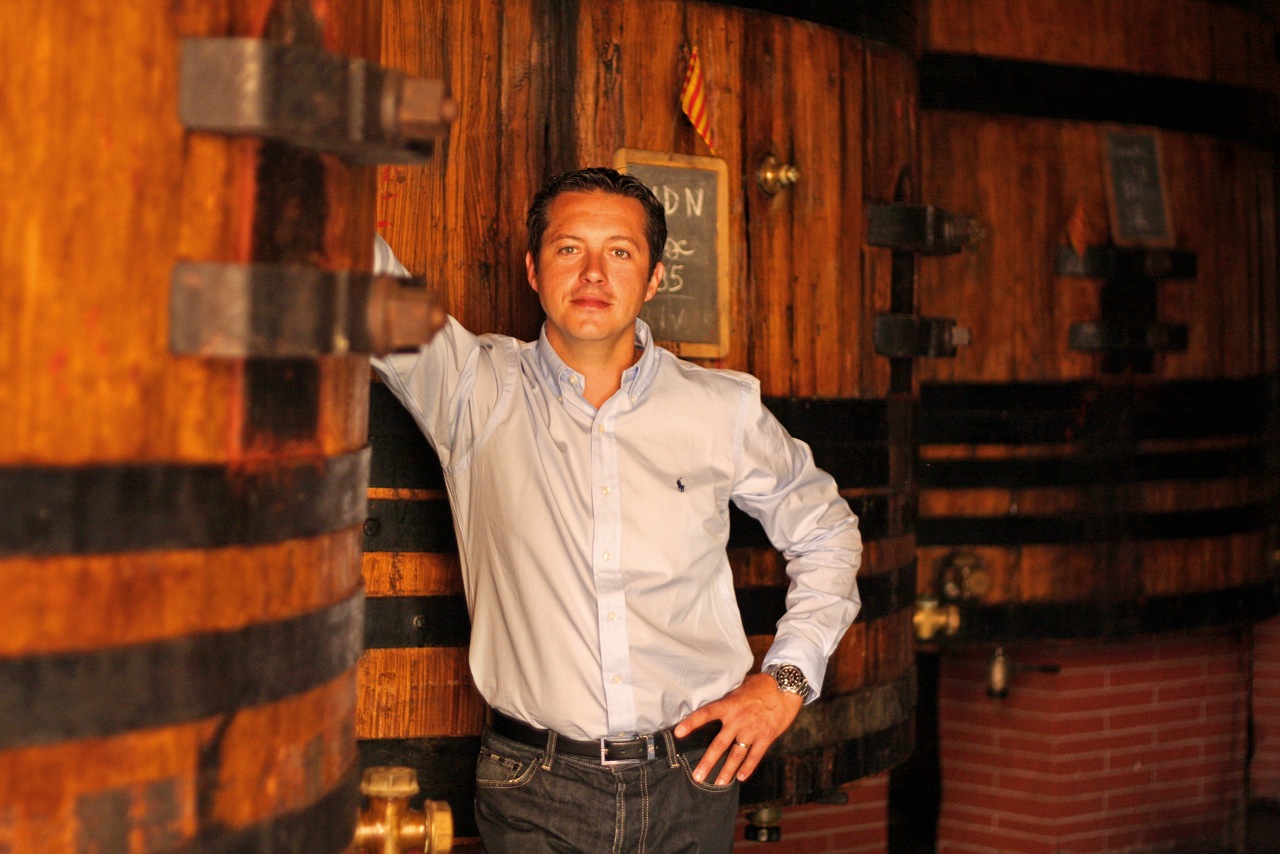 And then, even further along that end of
the wine continuum, there are fortified wines that age
for so long that they literally stand as testaments to
times long since past. Madeira is perhaps the most
famous among these: in just the past year I’ve had no
fewer than three bottles from the 19th century, and
they all were miraculous.
And then, even further along that end of
the wine continuum, there are fortified wines that age
for so long that they literally stand as testaments to
times long since past. Madeira is perhaps the most
famous among these: in just the past year I’ve had no
fewer than three bottles from the 19th century, and
they all were miraculous.
To the elite category of wines that effortlessly approach the ancient should be added Rivesaltes, the majestic yet little-known appellation in France’s Roussillon. This year I had the remarkably good fortune to be invited to a tasting and lunch at The Modern restaurant in NYC, featuring the utterly brilliant wines of Maison Cazes. It was a unique experience (or nearly so: a similar tasting had been held in London), an event that will not be repeated again. It was hosted by Cazes President Lionel Lavail, who represents his family’s seventh generation in the business, and Robert Kacher, the highly respected importer.
Rivesaltes,
Lavail pointed out, is the sunniest, windiest and
driest appellation in France, which makes the Cazes
commitment to organic and biodynamic farming far
easier than if it didn’t receive over 300 days of
sunshine each year. It is a part of France that 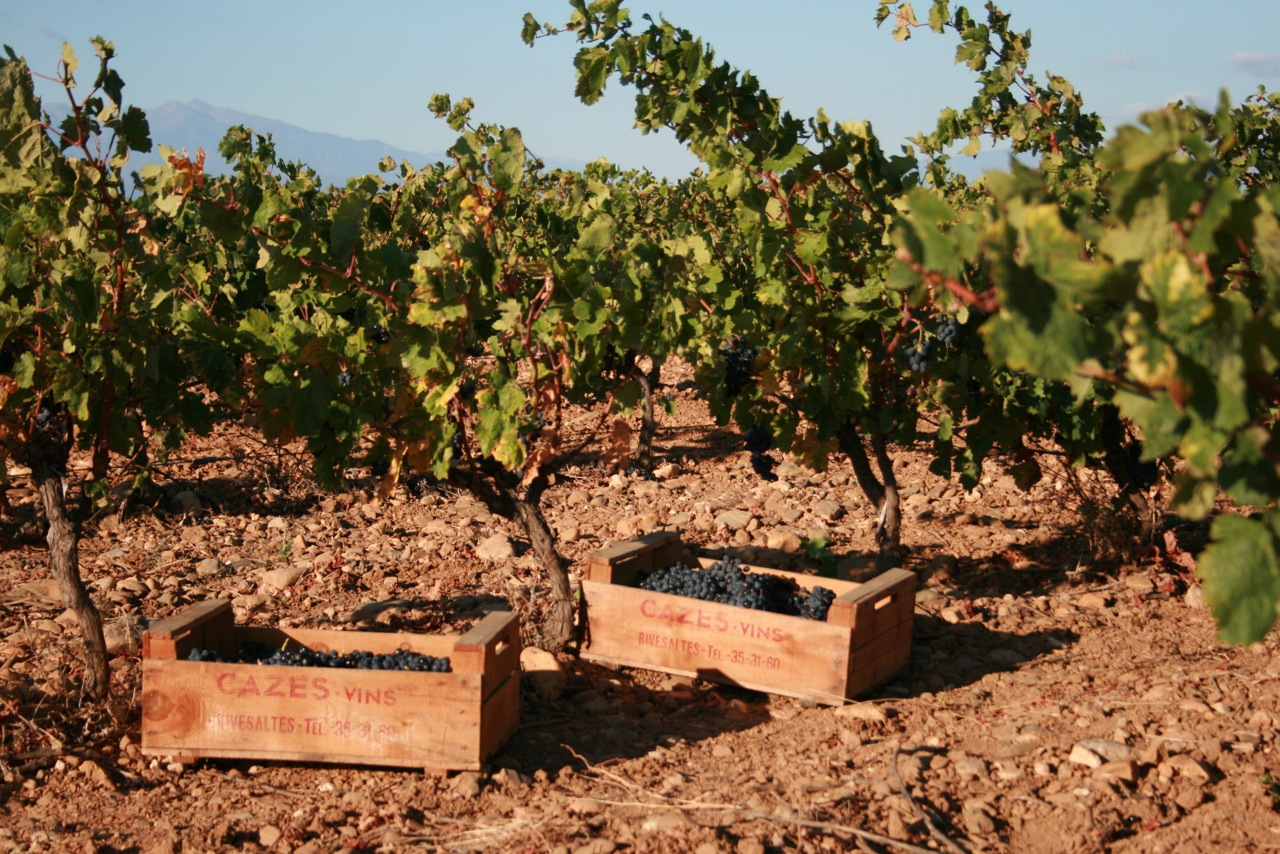 is
“particularly adapted to organic and biodynamic
farming,” he said.
is
“particularly adapted to organic and biodynamic
farming,” he said.
Rivesaltes represents the ne plus ultra of vin doux naturel, that is, wine whose fermentation has been halted by the addition of alcohol, which results in the wine retaining a fair amount of unfermented natural sugar, in this case between 100 and 110 grams per liter. What makes the Rivesaltes of Cazes so special is the fact that they’ve been made with grapes from vines that are in many cases more than 100 years old and have aged in barrels that are more than 250 years old.
The wines I tasted at The Modern--paired with a phenomenal menu by chef Gabriel Kreuther and pastry chef Marc Aumont--were all resting in their upright vats until January 2012, when they were bottled. The range of wines stretched from 1999 all the way back to 1931--meaning that some of them had benefited from six or seven or even eight decades of evolution in the barrel. No wonder, then, that Lavail described this and the London event as tasting “a piece of art from my place, the work of generations.” He added that he wanted “to show how, after 80 years, they are still fresh, still elegant.”
Indeed they were. The 1999, the youngest of the afternoon at 14 years old, smelled of dulce de leche, spice, graham crackers, dried apricots and nuts and tasted of sweet baked apple, grilled apricot and butterscotch. Its silkiness and elegance was offset by a smoky note on the mid-palate, creating a lovely tension between the two. The 1995, on the other hand, was a more high-toned wine, with fennel, star anise, and apple skin aromas, and flavors of white licorice, fennel, and a distinct minerality.
Then we jumped way back to 1962--from the Clinton years to the Kennedy ones--and the additional three decades made themselves known with earthy aromas of porcini powder, spice, dried apples and a whiff of flower, and a powerful palate speaking of black licorice, fig, sandalwood and charred orange peel. The finish here went on for what I’m pretty sure was a week. The 1960, by contrast, was far more feminine, with a remarkably fresh bouquet of ginger snaps, honey-glazed walnuts and persimmon that turned to flavors of honey, orange blossom and honeysuckle, especially on the finish.
The
1954 boasted an almost oxidized note in the best
possible sense, lending each sniff a subtly briny,
savory character, kissed with tobacco. The palate
here, however, was unexpectedly rich and sweet on the
attack, then more savory in the middle, with spice,
dried persimmon, and tobacco. The 1949 vintage
produced a wine with a far more explosive nose, an
apricot- and spice-singing beauty that reminded me, in
some regards, of a Palo Cortado Sherry. Flavors of
flowers, garrigue and 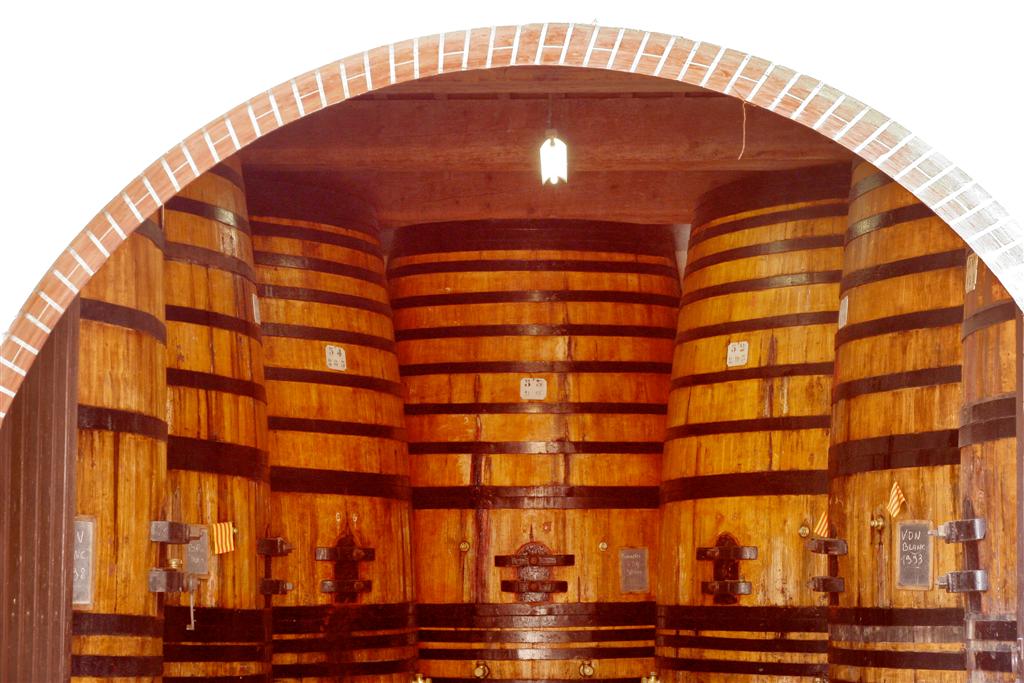 dried fig
followed through to a spicy, savory, lingering finish.
The 1945 was less giving, more subtle, with walnuts,
Brazil nuts, and salted caramel, as well as an
unexpected hit of lemon oil and orange. Completing the
trio of wines from the WWII decade was the 1943, all
dark and brooding and smelling of orange peel, orange
blossom, and cooked honey and a fresh, dry, almost
Sherry-like palate. Owing to the war, the wine was
kept in barrels and not bottled until 2012, yet
retained amazing vigor.
dried fig
followed through to a spicy, savory, lingering finish.
The 1945 was less giving, more subtle, with walnuts,
Brazil nuts, and salted caramel, as well as an
unexpected hit of lemon oil and orange. Completing the
trio of wines from the WWII decade was the 1943, all
dark and brooding and smelling of orange peel, orange
blossom, and cooked honey and a fresh, dry, almost
Sherry-like palate. Owing to the war, the wine was
kept in barrels and not bottled until 2012, yet
retained amazing vigor.
Finally, we came to the two
bottlings that seemed to have defied time, the 1933
and the 1931 (when the Empire State Building was
completed). The ’33 was mind-bogglingly great, with
dried apricots, persimmons and apples, coffee grinds,
spice, tobacco, orange oil, and kumquat on the nose
and a honeyed palate singing an aria of maple, orange
oil, licorice, salted caramel, sandalwood, charred
vanilla pod and what I’m pretty sure was manna from
heaven. The ’31, on the other hand, was more of a
thinker, a Sherry-referencing glassful of orange,
lime, nuts, and spices that walked the razor’s edge
between sweet and savory. It was an exotic, confident
wine that stood as a perfect counterpoint to the also
excellent 1933, and a ravishingly beautiful embodiment
of the range and longevity of these truly great wines.
Many of these wines are or will be available at NYC's Acker-Merrall Wines: Contact david@ackerwines.com.

“The
Saturday of Labor Day weekend, it took me an hour
to travel from Mill Valley to San Anselmo. All of
Marin was on the back roads while the rest of the
Bay Area's drivers were jammed, lemming-style,
onto Highway 101, a result of the Bay Bridge
closure. But go, I must, for there was food to be
eaten, a job to be done.”-- Christina
Mueller, "Taco Jane's a
neighborhood spot with heart," Marin Independent Journal.
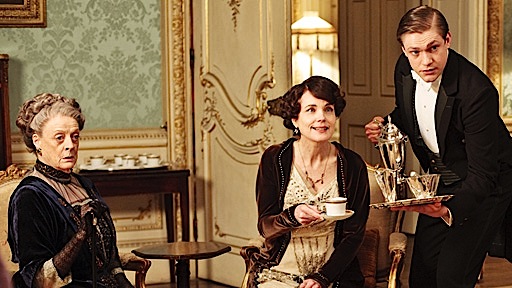 AND ALWAYS
COUNT THE SILVERWARE
AND ALWAYS
COUNT THE SILVERWAREBEFORE YOUR GUESTS LEAVE
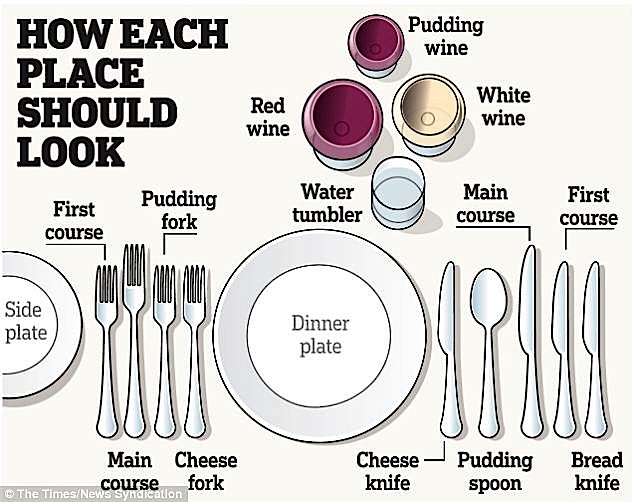
The Countess of Carnarvon,
mistress of Highclere Castle where the series
"Downton Abbey" is filmed, has criticized the
etiquette of the dinner table in the show, noting
that incorrect setting of the table for dinner,
the correct setting is shown in the illustration
here.
❖❖❖
Any of John Mariani's
books below may be ordered from amazon.com.
 |
My latest book, which just won the prize for best book from International Gourmand, written with Jim Heimann and Steven Heller, Menu Design in America, 1850-1985 (Taschen Books), has just appeared, with nearly 1,000 beautiful, historic, hilarious, sometimes shocking menus dating back to before the Civil War and going through the Gilded Age, the Jazz Age, the Depression, the nightclub era of the 1930s and 1940s, the Space Age era, and the age when menus were a form of advertising in innovative explosions of color and modern design. The book is a chronicle of changing tastes and mores and says as much about America as about its food and drink.
“Luxuriating vicariously in the pleasures of this book. . . you can’t help but become hungry. . .for the food of course, but also for something more: the bygone days of our country’s splendidly rich and complex past. Epicureans of both good food and artful design will do well to make it their coffee table’s main course.”—Chip Kidd, Wall Street Journal.
“[The menus] reflect the amazing craftsmanship that many restaurants applied to their bills of fare, and suggest that today’s restaurateurs could learn a lot from their predecessors.”—Rebecca Marx, The Village Voice. |
"Eating Italian will never be the same after reading John Mariani's entertaining and savory gastronomical history of the cuisine of Italy and how it won over appetites worldwide. . . . This book is such a tasteful narrative that it will literally make you hungry for Italian food and arouse your appetite for gastronomical history."--Don Oldenburg, USA Today. "Italian
restaurants--some good, some glitzy--far
outnumber their French rivals. Many of
these establishments are zestfully described
in How Italian Food Conquered the World, an
entertaining and fact-filled chronicle by
food-and-wine correspondent John F.
Mariani."--Aram Bakshian Jr., Wall Street
Journal.
"Equal parts
history, sociology, gastronomy, and just
plain fun, How Italian Food Conquered the
World tells the captivating and delicious
story of the (let's face it) everybody's
favorite cuisine with clarity, verve and
more than one surprise."--Colman Andrews,
editorial director of The Daily
Meal.com. "A fantastic and fascinating
read, covering everything from the influence
of Venice's spice trade to the impact of
Italian immigrants in America and the
evolution of alta cucina. This book will
serve as a terrific resource to anyone
interested in the real story of Italian
food."--Mary Ann Esposito, host of PBS-TV's
Ciao
Italia. "John Mariani has written the
definitive history of how Italians won their
way into our hearts, minds, and
stomachs. It's a story of pleasure over
pomp and taste over technique."--Danny Meyer,
owner of NYC restaurants Union Square Cafe,
Gotham Bar & Grill, The Modern, and
Maialino.
|
 |
 |
 |
 |
 |
 |
 |
 |
 Everett Potter's Travel Report:
Everett Potter's Travel Report: 
 Eating Las
Vegas is the new on-line site for
Virtual Gourmet contributor John A. Curtas.,
who since 1995 has been commenting on the
Las Vegas food scene and reviewing
restaurants for Nevada Public Radio.
He is also the restaurant critic for KLAS
TV, Channel 8 in Las Vegas, and his past
reviews can be accessed at KNPR.org.
Click on the logo below to go directly to
his site.
Eating Las
Vegas is the new on-line site for
Virtual Gourmet contributor John A. Curtas.,
who since 1995 has been commenting on the
Las Vegas food scene and reviewing
restaurants for Nevada Public Radio.
He is also the restaurant critic for KLAS
TV, Channel 8 in Las Vegas, and his past
reviews can be accessed at KNPR.org.
Click on the logo below to go directly to
his site.

Tennis Resorts Online: A Critical Guide to the World's Best Tennis Resorts and Tennis Camps, published by ROGER COX, who has spent more than two decades writing about tennis travel, including a 17-year stretch for Tennis magazine. He has also written for Arthur Frommer's Budget Travel, New York Magazine, Travel & Leisure, Esquire, Money, USTA Magazine, Men's Journal, and The Robb Report. He has authored two books-The World's Best Tennis Vacations (Stephen Greene Press/Viking Penguin, 1990) and The Best Places to Stay in the Rockies (Houghton Mifflin, 1992 & 1994), and the Melbourne (Australia) chapter to the Wall Street Journal Business Guide to Cities of the Pacific Rim (Fodor's Travel Guides, 1991).


MARIANI'S VIRTUAL GOURMET
NEWSLETTER is published weekly. Editor/Publisher: John
Mariani.
Contributing Writers: Christopher Mariani, Robert Mariani,
John A. Curtas, Edward Brivio, Mort Hochstein,
Suzanne Wright, and Brian Freedman. Contributing
Photographers: Galina Stepanoff-Dargery,
Bobby Pirillo. Technical Advisor: Gerry McLoughlin.
© copyright John Mariani 2013
